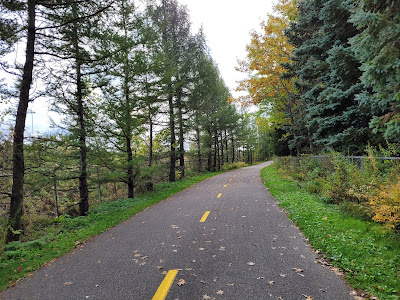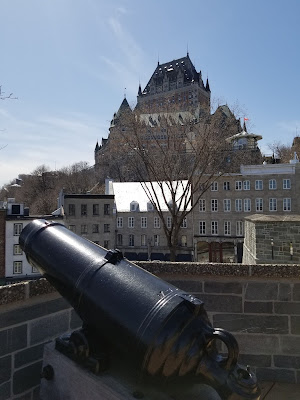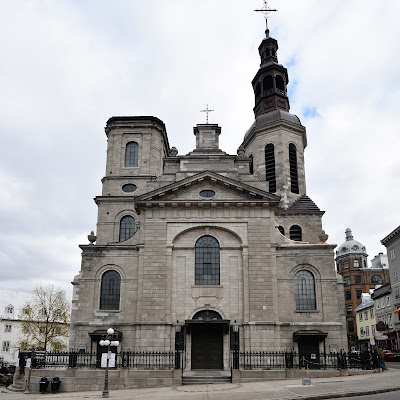Weekend Frenzy : Into and Around Quebec City
In a desperate and largely unsuccessful attempt to catch up with blogs, emails, requests, and photo editing we were late to bed last night, early to rise, and slow to set off this morning. When we set out into the overcast morning it was only 5°C, but already the bicycle trail was busy with cyclists out for a Saturday morning ride. We'd only been on the trail a few seconds when we got a friendly thumbs up from a passing cyclist, and it was the first of many friendly greetings today.
We followed the paved bicycling path through newer housing and condo developments as it paralleled the noisy and busy highway. Within half an hour we came to the Parc de la Chute-Montmorency. This small park was created around the Montmorency Falls, which are 83 m tall, making them 30 m taller than Niagara Falls. There is a Welcome Centre at the base of the falls, and visitors can board a cable car or climb a set of 400 wooden steps to the top of the falls.
There is an observation platform at the top of the cliff, and a suspension bridge over the crest of the waterfall. Visitors can also view the falls from a zip line, or from a rock climbing course on the side of the cliff.
Sadly, the Visitor's Centre and cable car were closed this morning, and there was quite a bit of construction being undertaken at the bottom of the falls. We walked out on the new observation boardwalk and paused to admire the awesome volume of water that was plummeting over the cliff, rising in a soft puff of mist as it hit the rocks at the bottom. It was easy to see why nearly 1 million people visit this awe inspiring location each year. Since the long stairway up was busy with people going both up and down we didn't make the climb with our large, unwieldy packs, but contented ourselves with the view from the base.
After the very impressive waterfall we continued along the paved cycling path towards Quebec City. We could see the forested hills rising up on the far side of the Saint Lawrence River, still bright with fall colours. However, the view was broken by the busy highway that paralleled the trail. As we approached the city, homes, soccer fields, motels, condos, and churches grew more frequent along the trail. On the far side of the waterway we could see Château Frontenac, the Plains of Abraham, and the walls of the Old City towering above a working harbour and an industrial sector along the shoreline. We were grateful for the beautiful cycling pathway as we made our way through the busy and fast paced outskirts of the city.
When we reached Beauport we picked up the Corridor du Littoral, which is a 48 km long cycling path that connects Montmorency in the east to Saint Augustin-de-Desmaures in the west. We will follow this trail, which is also part of the Route Verte cycling path, for 15-20 km before taking a ferry across to the south side of the seaway before continuing along it for another day tomorrow. We thoroughly enjoyed our hike down the Corridor du Littoral today, which had several rest areas for cyclists complete with benches, washrooms, and water fountains.
One of the highlights coming into the city was passing the Domaine de Maizerets. This 27 hectare urban park features 11 km of hiking trails that are open for cross-country skiing and snowshoeing in winter, as well as a large arboretum, and several historical buildings. The estate was purchased in 1696 by François Trefflé and Thomas Doyon, and then later acquired by the Séminaire de Québec in 1705. It is named after the priest Louis Ango Maizerets who was instrumental in acquiring the property for the seminary. There are several historical buildings on the grounds from the original farms, homes, and seminary which are open to visitors and can be rented for events.
As we passed the peaceful, forested grounds of the Domaine de Maizerets we were delighted to see a large and happy gathering going on inside the grounds. There was delicious looking food, wine, and several soccer games being played by small children as the adults socialized. It seemed like a joyous celebration of the 'joie de vivre' that is such a wonderful part of French culture.
The trail wove under the freeway, then crossed the railway tracks, and before we knew it, we were in Quebec City. Although walking underneath freeways isn't usually our favourite activity, we found some pretty cool street art under the bridges and roads of Quebec City.
We made our way through the Old City, amazed at how incredibly full it was. When we attempted to walk Quebec last spring we spent a day walking around the Old City after our quarantine was complete, the narrow winding streets were nearly deserted. We hadn't fully appreciated what a gift that was in terms of photographing the streets and interacting with the locals without having to navigate throngs of tourists.
On this cool Saturday morning the streets of Quebec were teeming with visitors, residents, students, and the less fortunate, who seemed to repeatedly identify us as potential marks to be jostled and bumped into. As we climbed up to the old Saint Roch quarter to drop our backpacks off at our modest accommodations there we were completely overwhelmed by the crowds.
Once we'd deposited out packs, we began our explorations of the Old Town by walking out to Dufferin's Terrace, which is a beautiful wooden boardwalk in the Upper Town that offers panoramic views out over the St Lawrence River. This public walkway, which was named in honour of Lord Dufferin, who served as Governor General of Canada from 1872-1878, was inaugurated in 1838, and has been a popular gathering place ever since, both during summer and winter.
When we visited early on a blustery morning last spring few people were out and about, and there were no street musicians or ice cream vendors in the colourful pavilions that bordered the walkway. Today the walkway was absolutely crowded with elegantly dressed and very warmly bundled people. Even so, we did receive a warm greeting and a 'Welcome to Quebec' from a friendly lady we passed along the way. We were also delighted to see and hear large v's of Snow Geese flying by overhead as we strolled along enjoying the view.
We began our walk on the boardwalk at the iconic Chateau Frontenac, which is an historic hotel that was originally built by the Canadian Pacific Railway Company. This impressive red brick, 18-floor building with its steep green copper roof was built in 1893, and became a National Historic Site of Canada in 1981. It occupies a prominent location in the Upper Town, commanding a panoramic view down the seaway.
Just in front of the Chateau Frontenac we passed the entrance to the Old Quebec Fenicular. There was a very large crowd waiting to board the two cable
driven passenger cars that link the Upper and Lower parts of Old Quebec City,
allowing pedestrians to avoid the steep climb or descent that must otherwise be
negotiated.
Also at this spot, located just below the boardwalk, was the Saint-Louis Forts and Chateaux National Historic Site. This archaeological crypt is located at the site of the official residence and seat of power of the governors from 1620 to 1834. Although it was not open for us to explore, glass windows in the boardwalk gave us a peak down into the historic courtyards located below.
As we continued along the boardwalk the sparkling seaway stretched out down below us on our left, and the solid grey stone walls of the Citadelle of Quebec rose above us on the other side. Quebec City is the only city in North America that is still surrounded by fortifications, and the walls of the Citadelle form part of this fortification. The walls surround an area of about 2,000 hectares. As we circled the ramparts we saw many large cannons pointing out across the water to Levis, but apparently they were never used.
The Citadelle is an active military installation, and a secondary residence of both the Canadian monarch and the Governor General of Canada. It is located atop Cap Diamant, the strategic importance of which was recognized by the French as early as 1608. Several defensive fortifications have been built on the site by both the French and the British. The modern Citadelle was constructed between 1820 and 1850, in an effort to secure Quebec City against a potential American attack, and it was used by the British until 1871. It is now a National Historic Site of Canada, and forms part of the Fortifications of the Quebec National Historic Site of Canada. The Citadelle is also located within the Historic District of Old Quebec, which was designated as a World Heritage Site in 1985.
Quebec City was created in 1608 by Samuel de Champlain, and it earned its UNESCO designation because it is recognized as the cradle of French civilization in North America. Walking through the winding stone streets and underneath the walls we could feel the richness of its history, and we wished we had more of an opportunity to explore.
As we made our way along the base of the Citadelle walls the pathway was surrounded by a tunnel of trees. Several Northern Flickers were hanging out in the branches, pretty much at eye level for us, and we could hear the rough caws of American Crows and the plaintive cries of Ring-billed Gulls carried on the wind.
The Duffrin Terrace soon brought us out onto the Plains of Abraham, which are now part of the Battlefields Park. The Battle of the Plains of Abraham took place on 13 September 1759, and it marked a turning point in the Seven Years War. After a three month siege, a British invasion force led by General James Wolfe defeated French troops led by the Marquis de Montcalm. Both commanding officers lost their lives in the battle, which ultimately led to the surrender of Quebec to the British and changed the course of North American history.
Today the Plains of Abraham are covered by a treed park which is criss-crossed by paved pathways that allow visitors to see various historical points of interest and learn about the events that took place there. We walked along the walls, enjoyed the view out over the water, learned about some of the archaeology that is taking place, and then walked along a forested Nature Trail which was bright with glowing fall colours.
We were delighted to discover that large and well-stocked bird feeders had been
hung at intervals along the forested footpath, and they were being frequented
by a variety of birds. The most prevalent species were Dark-eyed Juncos
and Black-capped Chickadees, but we were happy to spot several White-breasted
Nuthatches, a Golden-crowned Kinglet, a Hairy Woodpecker, and a small group of
female Redpolls. We were very excited about the Redpolls because they
were a first for us on the Trans Canada Trail!
After walking in a large loop through the Plains of Abraham we made our way back into the Old Town. Just before entering the walls we stopped to admire the Provincial Parliament buildings, which were built between 1877 and 1886. The light grey stone building, with its 52m tall tower, is adorned with statues of 22 people that were important to the history of the province. The compelling building was beautifully landscaped, but unfortunately it was also well guarded by a group of heavily armed security forces, so we didn't linger to take photographs.
Instead we passed under the rounded stone arches of the St Louis Gate and into the Old Town. The streets were lined with a mix of clothing boutiques, artisan shops and art galleries, restaurants and cafes, and old historic stone buildings.
Each building and shop front featured something unique or interesting, like an ornately carved wooden door, an artistically created awning, a unique sign, or decorative metalwork. The result was an eclectic and colourful street that begged to be explored. While we enjoyed wandering these streets during our extremely short visit in spring, they were far too full for our taste on this Saturday afternoon.
After stopping for a coffee and muffin in a lovely little cafe that was open for take-out, we made our way to the Notre Dame Basilica Cathedral. This is the oldest church in Canada, and the first church in Canada to be elevated to the rank of minor basilica in 1874. Four governors of New France, and several bishops of Quebec, including François de Laval, Quebec's first bishop, are buried in the crypt. Sadly it wasn't open to visitors today.
After wandering the Upper Town for a bit we made our way down one of the many steep wooden staircases to the Lower Town, and continued out to the harbour front. We paused to watch a work crew deploying an enormous rubber buoy into the water outside the cruise ship terminal, and then proceeded along the walkway to the Old Port. As we skirted the marina, which was only partially filled with sailboats, a young man on a bicycle stopped and asked us if we'd seen the Bald Eagle that had been reported on the harbour front, which he was looking for. Sadly we had not, but we kept a lookout for one after that.
The streets of the Old Port and the Lower Town were charming and beautiful, but many of the shops sold souvenirs, and the area was absolutely crowded with tourists. After so many months in the wide open spaces of the prairies, the tight press of slow moving people who would unexpectedly stop, reverse, or change course gave us a sense of claustrophobia.
After pausing to take a breather in the stone courtyard of the Place Royal, against the stone wall of the Notre-Dame-des-Victories Church, we enjoyed finding a huge mural on the side of a building which had portraits of important historical figures featured throughout what appeared to be a casual streetscape. In many ways, being surrounded by the art, culture, food, and history of Quebec is a real joy.
After a day of wandering up and down the steep streets of Old Quebec, we were ready for a break. We wandered back up to the train station, and sat outside in the late afternoon sunshine for a bit. Then it was time for a small dinner and turning our minds to planning for tomorrow.
As we end the day we feel a little shell shocked by the change we saw in Quebec
City compared to our last visit. The
same hotel room that we had quarantined in during the spring cost nearly three
times as much now. We hadn't realized it was a weekend when we walked
into Quebec City, so we hadn't anticipated that all the restaurants we tried,
from tiny bistros to pubs where fish and chips cost $46 a plate, would be fully
booked for the evening. It seems it is necessary to make reservations for
tours, meals, and accommodations well in advance during high season. While it
is wonderful to see the tourism industry beginning to recover from the
pandemic, we felt overwhelmed by the crowds, and a little disappointed that we
weren't able to find a way to connect with local culture slightly off the
beaten path this time around.
Quebec City is a magical place, filled with
history, culture, art, delicious food, and friendly people, and we only
scratched the surface. Hopefully we’ll
have a chance to return one day to explore further!
See you on the trail!
Remember to follow our entire adventure here : www.comewalkwithus.online















































































Comments
Post a Comment